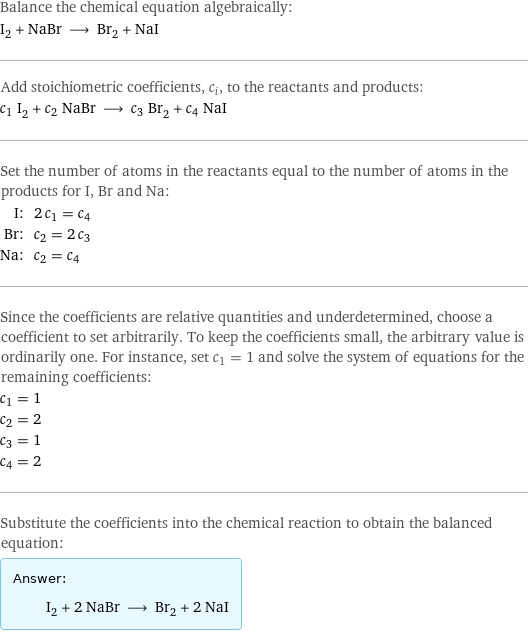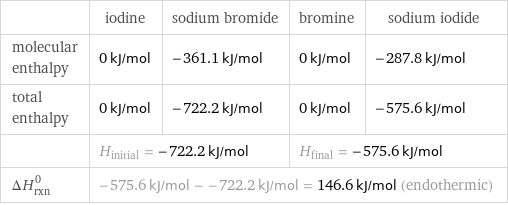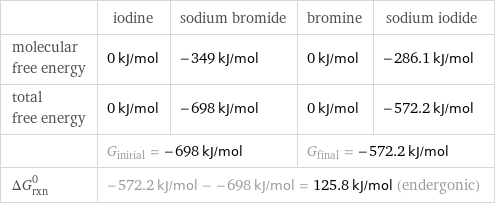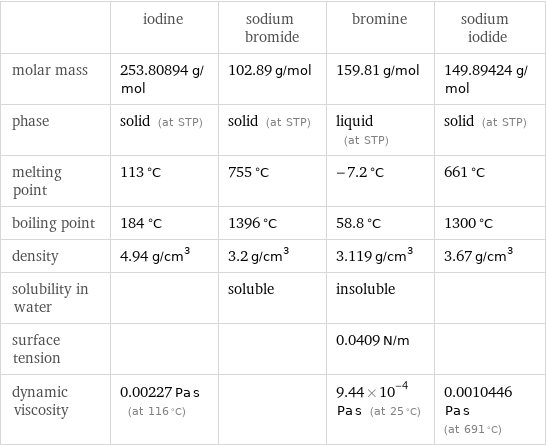Input interpretation

I_2 iodine + NaBr sodium bromide ⟶ Br_2 bromine + NaI sodium iodide
Balanced equation

Balance the chemical equation algebraically: I_2 + NaBr ⟶ Br_2 + NaI Add stoichiometric coefficients, c_i, to the reactants and products: c_1 I_2 + c_2 NaBr ⟶ c_3 Br_2 + c_4 NaI Set the number of atoms in the reactants equal to the number of atoms in the products for I, Br and Na: I: | 2 c_1 = c_4 Br: | c_2 = 2 c_3 Na: | c_2 = c_4 Since the coefficients are relative quantities and underdetermined, choose a coefficient to set arbitrarily. To keep the coefficients small, the arbitrary value is ordinarily one. For instance, set c_1 = 1 and solve the system of equations for the remaining coefficients: c_1 = 1 c_2 = 2 c_3 = 1 c_4 = 2 Substitute the coefficients into the chemical reaction to obtain the balanced equation: Answer: | | I_2 + 2 NaBr ⟶ Br_2 + 2 NaI
Structures

+ ⟶ +
Names

iodine + sodium bromide ⟶ bromine + sodium iodide
Reaction thermodynamics
Enthalpy

| iodine | sodium bromide | bromine | sodium iodide molecular enthalpy | 0 kJ/mol | -361.1 kJ/mol | 0 kJ/mol | -287.8 kJ/mol total enthalpy | 0 kJ/mol | -722.2 kJ/mol | 0 kJ/mol | -575.6 kJ/mol | H_initial = -722.2 kJ/mol | | H_final = -575.6 kJ/mol | ΔH_rxn^0 | -575.6 kJ/mol - -722.2 kJ/mol = 146.6 kJ/mol (endothermic) | | |
Gibbs free energy

| iodine | sodium bromide | bromine | sodium iodide molecular free energy | 0 kJ/mol | -349 kJ/mol | 0 kJ/mol | -286.1 kJ/mol total free energy | 0 kJ/mol | -698 kJ/mol | 0 kJ/mol | -572.2 kJ/mol | G_initial = -698 kJ/mol | | G_final = -572.2 kJ/mol | ΔG_rxn^0 | -572.2 kJ/mol - -698 kJ/mol = 125.8 kJ/mol (endergonic) | | |
Entropy

| iodine | sodium bromide | bromine | sodium iodide molecular entropy | 116.1 J/(mol K) | 84 J/(mol K) | 152.2 J/(mol K) | 91 J/(mol K) total entropy | 116.1 J/(mol K) | 168 J/(mol K) | 152.2 J/(mol K) | 182 J/(mol K) | S_initial = 284.1 J/(mol K) | | S_final = 334.2 J/(mol K) | ΔS_rxn^0 | 334.2 J/(mol K) - 284.1 J/(mol K) = 50.1 J/(mol K) (endoentropic) | | |
Equilibrium constant
![Construct the equilibrium constant, K, expression for: I_2 + NaBr ⟶ Br_2 + NaI Plan: • Balance the chemical equation. • Determine the stoichiometric numbers. • Assemble the activity expression for each chemical species. • Use the activity expressions to build the equilibrium constant expression. Write the balanced chemical equation: I_2 + 2 NaBr ⟶ Br_2 + 2 NaI Assign stoichiometric numbers, ν_i, using the stoichiometric coefficients, c_i, from the balanced chemical equation in the following manner: ν_i = -c_i for reactants and ν_i = c_i for products: chemical species | c_i | ν_i I_2 | 1 | -1 NaBr | 2 | -2 Br_2 | 1 | 1 NaI | 2 | 2 Assemble the activity expressions accounting for the state of matter and ν_i: chemical species | c_i | ν_i | activity expression I_2 | 1 | -1 | ([I2])^(-1) NaBr | 2 | -2 | ([NaBr])^(-2) Br_2 | 1 | 1 | [Br2] NaI | 2 | 2 | ([NaI])^2 The equilibrium constant symbol in the concentration basis is: K_c Mulitply the activity expressions to arrive at the K_c expression: Answer: | | K_c = ([I2])^(-1) ([NaBr])^(-2) [Br2] ([NaI])^2 = ([Br2] ([NaI])^2)/([I2] ([NaBr])^2)](../image_source/6a783da0a3303ad214a41bdc4cf1f796.png)
Construct the equilibrium constant, K, expression for: I_2 + NaBr ⟶ Br_2 + NaI Plan: • Balance the chemical equation. • Determine the stoichiometric numbers. • Assemble the activity expression for each chemical species. • Use the activity expressions to build the equilibrium constant expression. Write the balanced chemical equation: I_2 + 2 NaBr ⟶ Br_2 + 2 NaI Assign stoichiometric numbers, ν_i, using the stoichiometric coefficients, c_i, from the balanced chemical equation in the following manner: ν_i = -c_i for reactants and ν_i = c_i for products: chemical species | c_i | ν_i I_2 | 1 | -1 NaBr | 2 | -2 Br_2 | 1 | 1 NaI | 2 | 2 Assemble the activity expressions accounting for the state of matter and ν_i: chemical species | c_i | ν_i | activity expression I_2 | 1 | -1 | ([I2])^(-1) NaBr | 2 | -2 | ([NaBr])^(-2) Br_2 | 1 | 1 | [Br2] NaI | 2 | 2 | ([NaI])^2 The equilibrium constant symbol in the concentration basis is: K_c Mulitply the activity expressions to arrive at the K_c expression: Answer: | | K_c = ([I2])^(-1) ([NaBr])^(-2) [Br2] ([NaI])^2 = ([Br2] ([NaI])^2)/([I2] ([NaBr])^2)
Rate of reaction
![Construct the rate of reaction expression for: I_2 + NaBr ⟶ Br_2 + NaI Plan: • Balance the chemical equation. • Determine the stoichiometric numbers. • Assemble the rate term for each chemical species. • Write the rate of reaction expression. Write the balanced chemical equation: I_2 + 2 NaBr ⟶ Br_2 + 2 NaI Assign stoichiometric numbers, ν_i, using the stoichiometric coefficients, c_i, from the balanced chemical equation in the following manner: ν_i = -c_i for reactants and ν_i = c_i for products: chemical species | c_i | ν_i I_2 | 1 | -1 NaBr | 2 | -2 Br_2 | 1 | 1 NaI | 2 | 2 The rate term for each chemical species, B_i, is 1/ν_i(Δ[B_i])/(Δt) where [B_i] is the amount concentration and t is time: chemical species | c_i | ν_i | rate term I_2 | 1 | -1 | -(Δ[I2])/(Δt) NaBr | 2 | -2 | -1/2 (Δ[NaBr])/(Δt) Br_2 | 1 | 1 | (Δ[Br2])/(Δt) NaI | 2 | 2 | 1/2 (Δ[NaI])/(Δt) (for infinitesimal rate of change, replace Δ with d) Set the rate terms equal to each other to arrive at the rate expression: Answer: | | rate = -(Δ[I2])/(Δt) = -1/2 (Δ[NaBr])/(Δt) = (Δ[Br2])/(Δt) = 1/2 (Δ[NaI])/(Δt) (assuming constant volume and no accumulation of intermediates or side products)](../image_source/9c618af8c920738fbe45697a77540362.png)
Construct the rate of reaction expression for: I_2 + NaBr ⟶ Br_2 + NaI Plan: • Balance the chemical equation. • Determine the stoichiometric numbers. • Assemble the rate term for each chemical species. • Write the rate of reaction expression. Write the balanced chemical equation: I_2 + 2 NaBr ⟶ Br_2 + 2 NaI Assign stoichiometric numbers, ν_i, using the stoichiometric coefficients, c_i, from the balanced chemical equation in the following manner: ν_i = -c_i for reactants and ν_i = c_i for products: chemical species | c_i | ν_i I_2 | 1 | -1 NaBr | 2 | -2 Br_2 | 1 | 1 NaI | 2 | 2 The rate term for each chemical species, B_i, is 1/ν_i(Δ[B_i])/(Δt) where [B_i] is the amount concentration and t is time: chemical species | c_i | ν_i | rate term I_2 | 1 | -1 | -(Δ[I2])/(Δt) NaBr | 2 | -2 | -1/2 (Δ[NaBr])/(Δt) Br_2 | 1 | 1 | (Δ[Br2])/(Δt) NaI | 2 | 2 | 1/2 (Δ[NaI])/(Δt) (for infinitesimal rate of change, replace Δ with d) Set the rate terms equal to each other to arrive at the rate expression: Answer: | | rate = -(Δ[I2])/(Δt) = -1/2 (Δ[NaBr])/(Δt) = (Δ[Br2])/(Δt) = 1/2 (Δ[NaI])/(Δt) (assuming constant volume and no accumulation of intermediates or side products)
Chemical names and formulas

| iodine | sodium bromide | bromine | sodium iodide formula | I_2 | NaBr | Br_2 | NaI Hill formula | I_2 | BrNa | Br_2 | INa name | iodine | sodium bromide | bromine | sodium iodide IUPAC name | molecular iodine | sodium bromide | molecular bromine | sodium iodide
Substance properties

| iodine | sodium bromide | bromine | sodium iodide molar mass | 253.80894 g/mol | 102.89 g/mol | 159.81 g/mol | 149.89424 g/mol phase | solid (at STP) | solid (at STP) | liquid (at STP) | solid (at STP) melting point | 113 °C | 755 °C | -7.2 °C | 661 °C boiling point | 184 °C | 1396 °C | 58.8 °C | 1300 °C density | 4.94 g/cm^3 | 3.2 g/cm^3 | 3.119 g/cm^3 | 3.67 g/cm^3 solubility in water | | soluble | insoluble | surface tension | | | 0.0409 N/m | dynamic viscosity | 0.00227 Pa s (at 116 °C) | | 9.44×10^-4 Pa s (at 25 °C) | 0.0010446 Pa s (at 691 °C)
Units
